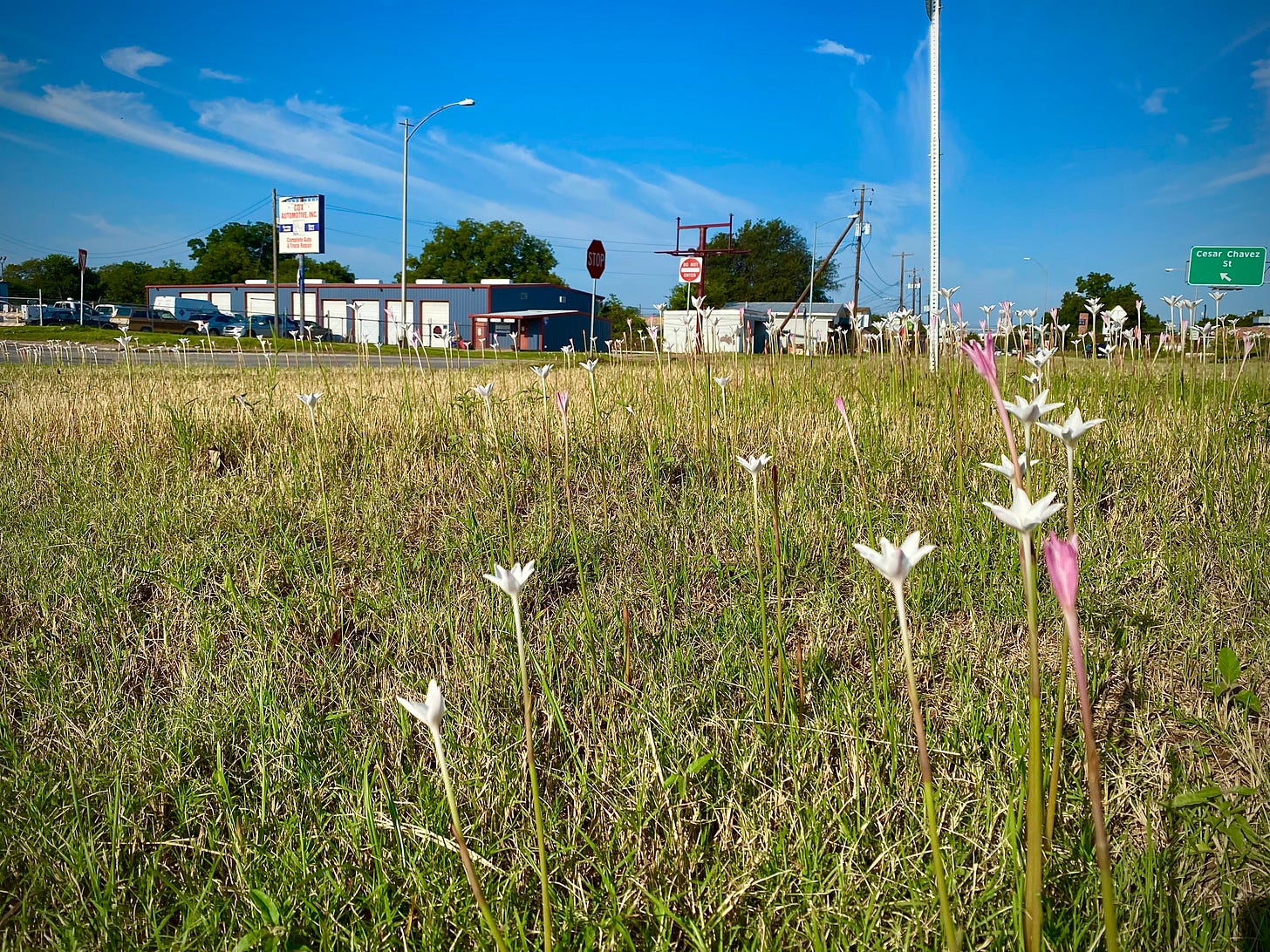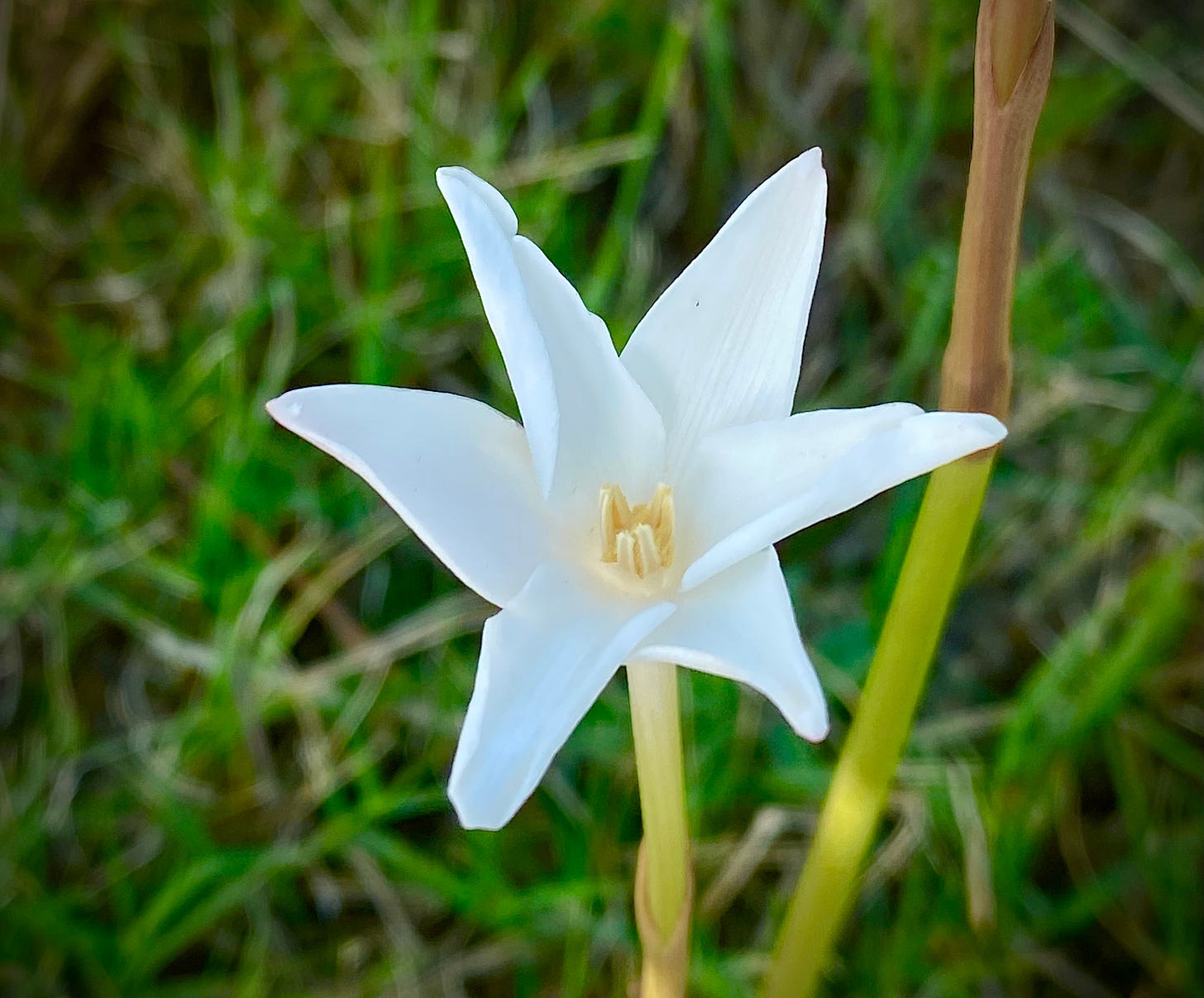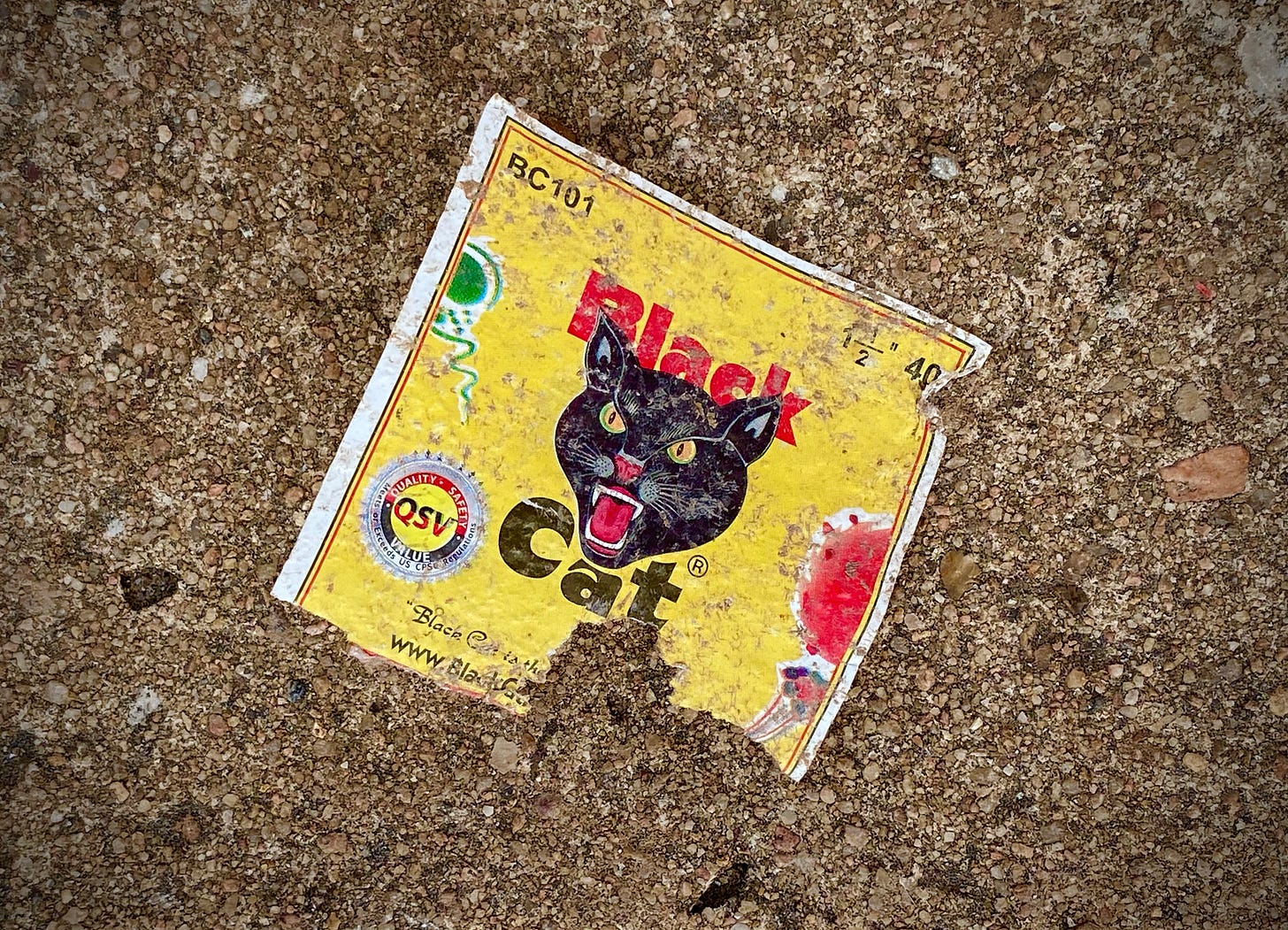Drainage ditch Hermetics
Last Saturday morning as we came down from the old bridge we found the median at the base of the onramp bursting with the tall green stalks and creamy white flowers of a plant I had seen many times before but never really paid much attention to, maybe because I had never seen them in such numbers. They came at the end of a week of nightly showers that opened October and made it feel authentically autumnal in a way Texas rarely feels, and they were everywhere. Or more accurately, everywhere one normally sees no signs of life other than the invasive ornamental grasses the municipal road crews plant after the bulldozers are done—in medians, traffic islands, and empty lots.
I have a heretical reluctance, or at least wariness, of learning to identify all of the distinct species I find on my rambles. I love the lexicographical diversity it yields, and the way it obliquely quantifies our diminishing biodiversity. Knowing a thing’s name is what gives you access to the accumulated human knowledge about it. But taxonomy is also the enemy of wonder. The naming of a thing enacts a kind of appropriation, and an alienation, that is a power to use with restraint. And many of the things one encounters in nature don’t really adhere to the documented order. So I don’t feel bad about walking by examples of a particular plant for years before I bother to learn what people call it.
This newsletter has encouraged me to correct that tendency, even as I persist in trying to improvise my own names for things, or find the names they were given in other languages and cultures. When I look up the scientific classification, I try to start with the random field guides I bring back from used bookstores. If you look in Wildflowers of Texas (1984) by Geyata Ajilvsgi, you will find that this particular rain lily so common in Central Texas is also called the evening star, for reasons apparent when you look at its open flower. That it emerged on a week when Venus appeared at sunset in the western sky, in tandem with the crescent of a new moon, made me wonder if that popular name also reveals the plant’s connection to some seasonal astronomical recurrence.
The rain lily’s scientific name is Cooperia drummondi, which comes from a Scottish naturalist named Thomas Drummond who landed at Velasco in 1833, followed the rivers inland as far as the Edwards Plateau, and brought back samples of 750 species of plants and 150 species of birds for the Europeans to marvel at. Maybe it’s because I have been re-reading chunks of Blood Meridian before bed that Drummond’s project sounds more sinister to me than it should.
The rain lilies only last a few days, and by the end of the week they had mostly dried out and gone to brown. Looking this weekend at the picture I took Thursday of one of the later crops, a floral orchestra of green and white trumpets in the drainage culvert outside the motor oil distributor, I got to thinking about another seasonal connection these flowers have. Ephemeral markers of Columbus Day, and resilient remnants of what was here before Columbus.
Not far from that spot, I came upon the dislocated badge of a late model sedan named after the Roman psychopomp, who was also the god of the grain trade that underpins Anthropocene civilization. He had lost most of the last letter of his name, making it read closer to his German variant. You couldn’t tell what model it came from, or how long ago was the wreck that had severed it from the grille, but chances are it was a Grand Marquis, apex of Ford’s effort to tie the brand to middle class aspiration. Mr. Wednesday’s last ride.
Thursday night the news broke that a newer automotive brand, this one named after a more modern demigod of communications, is relocating its corporate headquarters here from California. Since last summer, Tesla has been building its newest “Gigafactory” a few miles downriver from here, an undertaking of big engineering that looks even more dystopian in person than the ominous photos on the front page of the local paper. Tesla’s celebrity CEO reaffirmed his vision that the riverfront portion of the site will be remade into an “ecological paradise,” but the truth is that stretch of the Colorado already is one, or as close to that as any pocket of urban wild can ever be. The real question is how badly will Tesla be able to mar our local environment in order to build its supposedly eco-friendly Cybertrucks.
The same night as Tesla’s announcement, the state climatologist issued a study that forecast the Texas weather in 2036. Just as hot as you think. Triple-digit temps half the days of the year, prolonged drought, and the inevitable arrival of the city-destroying wildfires we have thus far mostly avoided. One wonders when it will get so hot people really have to leave.
Will the middle class climate change refugees of the near future flee Texas in Teslas? What will they do if the charging stations start to fail, along with our overstretched power grid? Maybe they will follow the linear clouds the last jets paint across the northern sky, to where the cool water is. I doubt that Elon Musk or anyone else will be able to escape the mess we have made of this planet.
Upcoming appearances
Field Notes will be off next Sunday, as I will be traveling much of the week.
This Tuesday at 4:30 Eastern I will be giving a talk at the Cyberjustice Laboratory at the University of Montreal law school, on the subject of how science fiction imagines the future of law. It’s a great opportunity to try to weave together some of the threads I’ve been tracking over the past few years in my work, and will be my first trip out of the country since Covid. Ironically, the Cyberjustice Lab has had its website hacked, so their main event page is down. But if you are in Montreal, you can attend in person, and if you’re not, you can join us on Zoom. It should be a fun and interesting discussion.
Friday afternoon I will be speaking at the University of Iowa College of Law in Iowa City, about what ethical lessons legal fictions can teach real lawyers.
Next Saturday and Sunday I will be reading from new work and participating in panels at Armadillocon, Austin’s annual conference of imaginative literature. It’s the first in-person public event I will have been to in more than a year, and I’m looking forward to seeing a lot of old friends and meeting some new ones. The schedule is still being finalized, but it looks like I will have panels both days, including a signing Saturday noon and a reading Sunday noon. The con has a pretty robust health policy, which is good to see. I hope to see some of you there.
Last week this newsletter hit a big subscription milestone. I had no expectations when I started this after finishing my last book other than to make a sandbox to explore this somewhat unusual material I have been accumulating, so the continued response from a remarkable diversity of folks has been affirming and deeply appreciated. Thanks to each of you for reading and sharing Field Notes.
Goldenrod season
Just across the street from the Mercury badge on Saturday, I saw the first goldenrod of the season, pushing the invasive Johnson grass out of the way in the feral planters of the old warehouse where they store surplus medical equipment.
Thursday afternoon I came upon a tiny horror show on our patio: a grasshopper eating out the hollowed remains of a cicada. I have never heard of a grasshopper eating flesh, especially when there is ample green foliage around, but I suppose like most creatures they are opportunists. Maybe it was a special occasion, or just a warm-up for Halloween. It makes you wonder what they will do with those remarkable mandibles if climate change materially depletes their normal food supply.
Have a safe week.












Another fascinating and informative news letter. No wonder I look forward to seeing it each week. Thanks.